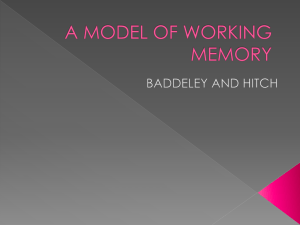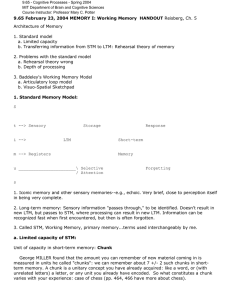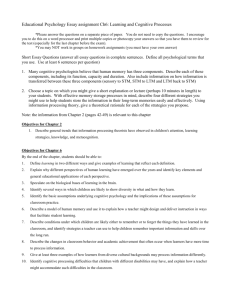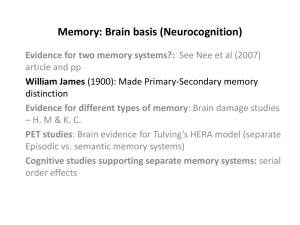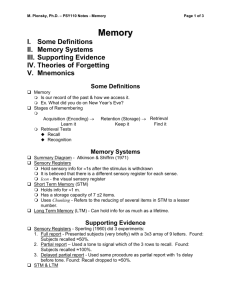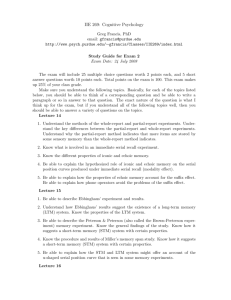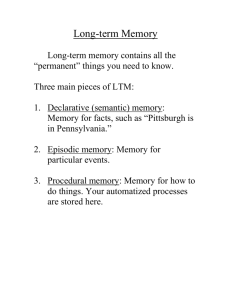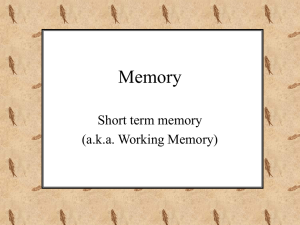week8_workingmem1
advertisement
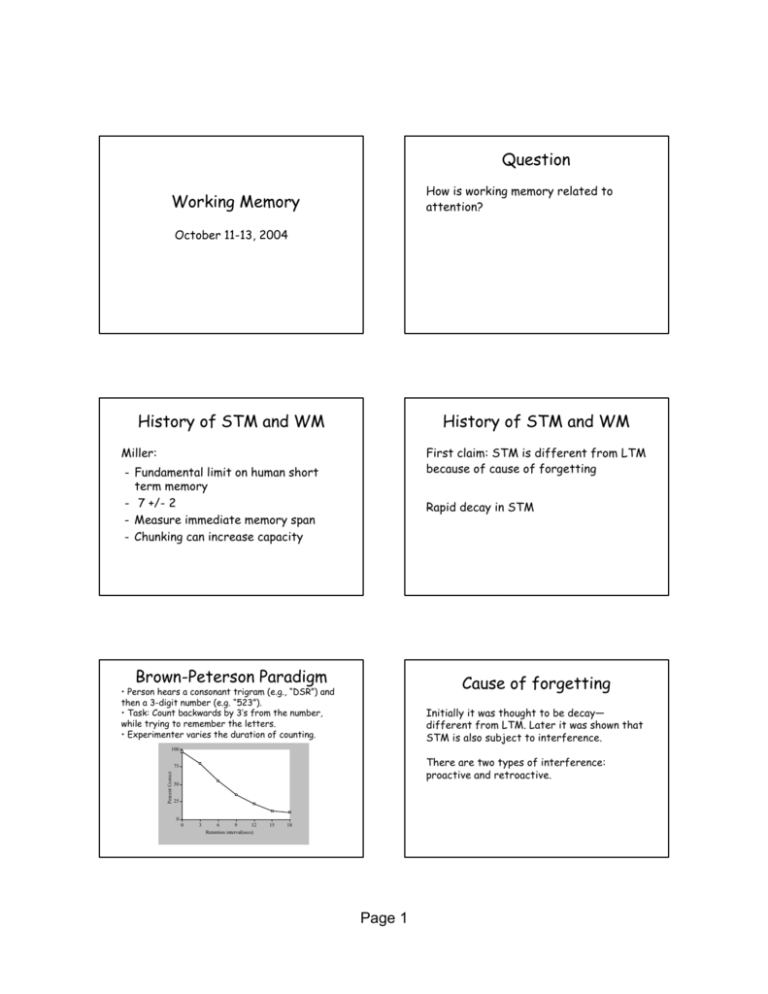
Question How is working memory related to attention? Working Memory October 11-13, 2004 History of STM and WM History of STM and WM Miller: First claim: STM is different from LTM because of cause of forgetting - Fundamental limit on human short term memory - 7 +/- 2 - Measure immediate memory span - Chunking can increase capacity Rapid decay in STM Brown-Peterson Paradigm Cause of forgetting • Person hears a consonant trigram (e.g., “DSR”) and then a 3-digit number (e.g. “523”). • Task: Count backwards by 3’s from the number, while trying to remember the letters. • Experimenter varies the duration of counting. Initially it was thought to be decay— different from LTM. Later it was shown that STM is also subject to interference. 100 There are two types of interference: proactive and retroactive. Percent Correct 75 50 25 0 0 3 6 9 12 Retention interval(secs) 15 18 Page 1 Proactive interference Retroactive Interference Brown-Peterson paradigm: people are 95% accurate on the first trial, even with a 30 second delay Brown-Peterson paradigm: delay has a much worse impact if the delay is filled detecting syllables, than detecting tones amid white noise. STM vs. LTM Phonological Code in STM Second claim: Codes or representations are different Acoustic confusion effect - Words presented visually lead to errors of sound But later determined other codes: - Spatial - Semantic Release from Proactive Interference Transfer from STM to LTM Serial Position effects 100 This result indicates that there is also a semantic code in STS - Remember a list of words 80 Percent correct B-P paradigm Professions 60 Meats Flowers 40 Vegetables Fruits 20 0 1 2 3 4 5 Trial Page 2 Serial Position Effects Serial Position Effects 80% Recency effect: last words in list are remembered better Proportion Correct Primacy effect: first words in the list are remembered better 10% 0 Position in List 30 Serial Position Effects Serial Position Effects Recency effect: last few words are still in STM Primacy effect: first words are remembered because they are likely to have entered LTM How to test this? Multi-store (modal) Model Problems? Atkinson and Shiffrin Sensory à STM à LTM Page 3 Problems… - Confounds between codes and processes Assumption of serial processing from STS to LTS - - What did neuropsych show? - LTS likely to have influence STS - not consistent with neuropsych data Dissociation between STM and LTM But, patients with deficits in STM could still have intact LTM - Failure on digit span - Intact LTM for words, etc. LTM not necessarily related to rehearsal Thinking about meaning Response: Craik and Lockhart • “Depth”: thinking about meaning, and how the to-be-remembered material relates to things that you already know. Levels of Processing • Shallow processing: means thinking about physical characteristics of the stimulus. –Deep processing: “What does ‘cake’ make you think of?” –Shallow processing: “How many letters are in the word ‘cake’?” Craik & Tulving (1975) Level of Processing Question to answer Sample “yes” stimulus Sample “no” stimulus Structural Is the word in capital letters? TABLE table Phonemic Does the word rhyme with weight? crate MARKET Category Is the word a type of fish? SHARK heaven Sentence “He met a ___ in the street. FRIEND cloud Results 1 0.75 0.5 0.25 0 Structural Phonemic Category Sentence Level of Processing Page 4 Primary Memory The Working Memory Model An activation of processes—not a structure as in STM Much of what we know about primary memory was inspired by a particular model of primary memory called Working Memory - Focus on process instead of storage Phonological Loop Similar to Baddeley’s Working Memory capacity The Working Memory Model Central Executive Visuospatial Sketchpad Phonological Loop Workspace as well as short-term storage The phonological loop has two components: 1. Phonological store - Store about 2 s of auditory information Information can enter from environment or from articulatory control process 2. Articulatory control process - Phonological Loop literally, talking to yourself Visuospatial sketchpad Articulatory suppression studies Storage of visual and spatial information. Separate “visual” and “spatial”? Page 5 Central executive Supervisory Attentional System Cognitive supervisor and/or scheduler, integrating information from multiple sources and making decisions about strategies to be used on tasks Norman and Shallice - Activation of schemas - Sometimes schemas conflict and need process of contention scheduling Double dissociations New component to WM Support claim of two sub-components of working memory Central Executive - How to test? - Normals and human lesion patients Visuospatial sketchpad Episodic Buffer Episodic Buffer Phonological Loop Other approaches to WM - Dynamic models - WM as activated subset of LTS Influence of LTM on short-term storage - Eliminate need for multiple memory structures? Hold information integrated across time and space - Varying ideas on executive control - Central executive - Distributed attention Page 6


